Thank you all for your precious help.
Unfortunately I don't have any schematic: I still have its original pamphlet with the schematic pocket empty. I doubt the company ever provided them actually. I've even tried to call them at some point, the number is still active with an answering machine, but they never called me back.
I did take some pictures, even though the boards are placed vertically and right now I don't feel confortable to go further with disassembling.
Could I try with some sort of filter/resistor at the input? Top tier cables don't seem to help.
An oscilloscope is on my purchase list, but I fear I am not skilled enough for understanding how to use it well.You will probably need an oscillocope to track this down. Do you have a schematic? Didn't find it online. Posting a few hi-res pix of the internals MIGHT help, looking for obvious signs of stress...
Unfortunately I don't have any schematic: I still have its original pamphlet with the schematic pocket empty. I doubt the company ever provided them actually. I've even tried to call them at some point, the number is still active with an answering machine, but they never called me back.
I did take some pictures, even though the boards are placed vertically and right now I don't feel confortable to go further with disassembling.
Could I try with some sort of filter/resistor at the input? Top tier cables don't seem to help.
Attachments
-
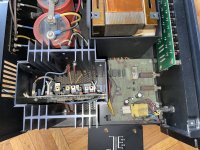 2022-09-28 13.23.39.jpg549.3 KB · Views: 160
2022-09-28 13.23.39.jpg549.3 KB · Views: 160 -
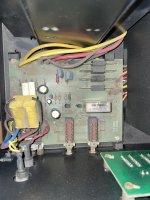 2022-09-28 13.23.43.jpg535.5 KB · Views: 157
2022-09-28 13.23.43.jpg535.5 KB · Views: 157 -
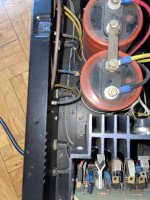 2022-09-28 13.23.48.jpg454.6 KB · Views: 153
2022-09-28 13.23.48.jpg454.6 KB · Views: 153 -
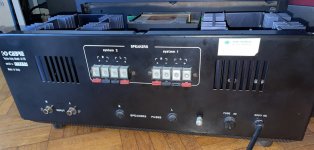 2022-09-28 13.23.54.jpg258.5 KB · Views: 149
2022-09-28 13.23.54.jpg258.5 KB · Views: 149 -
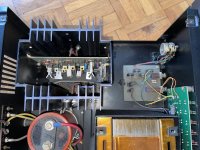 2022-09-28 13.24.04.jpg561.8 KB · Views: 142
2022-09-28 13.24.04.jpg561.8 KB · Views: 142 -
 2022-09-28 13.24.09.jpg408.1 KB · Views: 148
2022-09-28 13.24.09.jpg408.1 KB · Views: 148 -
 2022-09-28 13.24.14.jpg367 KB · Views: 140
2022-09-28 13.24.14.jpg367 KB · Views: 140 -
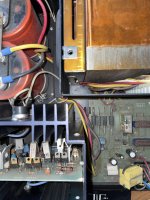 2022-09-28 13.25.23.jpg493.4 KB · Views: 139
2022-09-28 13.25.23.jpg493.4 KB · Views: 139 -
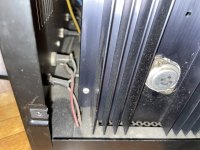 2022-09-28 13.25.31.jpg466 KB · Views: 134
2022-09-28 13.25.31.jpg466 KB · Views: 134 -
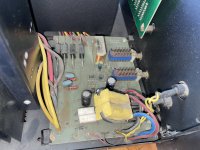 2022-09-28 13.26.02.jpg518.6 KB · Views: 138
2022-09-28 13.26.02.jpg518.6 KB · Views: 138 -
 2022-09-28 13.26.10.jpg167.2 KB · Views: 135
2022-09-28 13.26.10.jpg167.2 KB · Views: 135 -
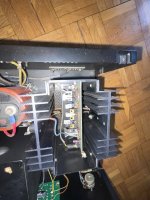 2022-09-28 13.35.53.jpg501.6 KB · Views: 131
2022-09-28 13.35.53.jpg501.6 KB · Views: 131 -
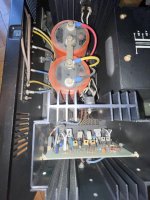 2022-09-28 13.36.04.jpg500.9 KB · Views: 123
2022-09-28 13.36.04.jpg500.9 KB · Views: 123 -
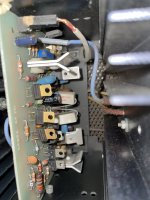 2022-09-28 13.38.38.jpg382.5 KB · Views: 123
2022-09-28 13.38.38.jpg382.5 KB · Views: 123 -
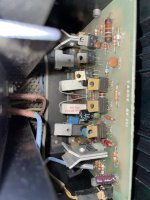 2022-09-28 13.38.49.jpg380.7 KB · Views: 149
2022-09-28 13.38.49.jpg380.7 KB · Views: 149
If that amp doesn't hum with shorted inputs, there is nothing wrong with it yet.
Seal it back up and focus on what's connected to it, because that is the cause of hum, not the amp.
Seal it back up and focus on what's connected to it, because that is the cause of hum, not the amp.
I connected my phone instead of the preamp: no buzz.If that amp doesn't hum with shorted inputs, there is nothing wrong with it yet.
Seal it back up and focus on what's connected to it, because that is the cause of hum, not the amp.
Then I connected the preamp again: no buzz at the beginning, but after 5-10 minutes it reappeared.
I connected my phone again: still buzzing, but while shorting inputs the buzz disappears.
Logically then, you should turn your attention to the preamp or preamp section if it's an integrated amp. Since the hum problem only appears after 5-10 minutes, it would seem to be heat related and likely the only places you would find warm or hot in a preamp, would be the power supply or supplies, since there are usually several small, regulated power supplies of both positive and negative polarity for each channel and for the various stages like the phono, line level, tone controls and output buffer, which should be identifiable by their regulator ICs or perhaps in this case, small power transistors in discrete voltage regulator circuits.
Last edited:
Thank you. It's a standalone final, so I will try some cross checks with other machines.Logically then, you should turn your attention to the preamp or preamp section if it's an integrated amp. Since the hum problem only appears after 5-10 minutes, it would seem to be heat related and likely the only places you would find warm or hot in a preamp, would be the power supply or supplies, since there are usually several small, regulated power supplies of both positive and negative polarity for each channel and for the various stages like the phono, line level, tone controls and output buffer, which should be identifiable by their regulator ICs or perhaps in this case, small power transistors in discrete voltage regulator circuits.
This is my first thread and I am surprised on how kind and helpful all of you are!
Wouldn't this indicate that the problem is in the power amp?I connected my phone instead of the preamp: no buzz.
Then I connected the preamp again: no buzz at the beginning, but after 5-10 minutes it reappeared.
I connected my phone again: still buzzing, ...
The delay in time suggests the issue may be caused dry joints which are activated by a change in temperature. The buzz persistence after reconnecting the phone corroborates this.
I'd also suggest that all mounting screws inside could be 'snugged up' in case a ground critical to operation is perhaps a bit loose. - including rear jacks mounting.The delay in time suggests the issue may be caused dry joints which are activated by a change in temperature. The buzz persistence after reconnecting the phone corroborates this.
We're not dealing with plumbing here, just small screws, so no need to use enormous torque on them.... just snug them up.
And yes, a magnifying glass or goggles to inspect solder joints is what I did for decades of inspections on customer equipment.
Hello everyone, I have a small update to my case.
I tried a lot of setups, but there was no way to make the buzz go away, so I tried with a ground loop insulator (shame on me). When I switched my amp on what I got was a 500W absorption on the outlet and smoke coming from both sides of the chassis.
Quickly disconnected, the amp seemed to run fine (buzz still present tho) but I wanted to play it safe and I took it to service. The repairman said he disassembled it and found it was in perfect condition. He could not hear any buzz as well.
Wheh I took it back home I listened to it for few hours and it worked like charm, but when I was about to go to bed I restarted it once more and the buzz suddently came back. So I took it as a challenge.
The next day I disassembled it myself and did a deep soak with contact cleaner to the boards. What looks like the PSU board was quite dirty actually.
Then I removed the big 63V 15000 uF filter capacitors (nobody ever did that before) and took them to my local store, where the gentleman found some NOS 100V 16000 uF for less than 15 EUR each. I wasn't sure they would have fit so I came back home and put the old ones back in. The amp was dead silent, and so it has been for the last three days.
I don't know what it happened, and not even sure if the filter caps have something to do with it. Now I am happy with what I have, but should I consider getting those caps from the store anyways and keep them? The price seems good, but I'm not sure if I would ever need to replace the ones I have and even if a couple of 100V 16000 uF would do the job of two 63V 15000 uF.
Thank you.
I tried a lot of setups, but there was no way to make the buzz go away, so I tried with a ground loop insulator (shame on me). When I switched my amp on what I got was a 500W absorption on the outlet and smoke coming from both sides of the chassis.
Quickly disconnected, the amp seemed to run fine (buzz still present tho) but I wanted to play it safe and I took it to service. The repairman said he disassembled it and found it was in perfect condition. He could not hear any buzz as well.
Wheh I took it back home I listened to it for few hours and it worked like charm, but when I was about to go to bed I restarted it once more and the buzz suddently came back. So I took it as a challenge.
The next day I disassembled it myself and did a deep soak with contact cleaner to the boards. What looks like the PSU board was quite dirty actually.
Then I removed the big 63V 15000 uF filter capacitors (nobody ever did that before) and took them to my local store, where the gentleman found some NOS 100V 16000 uF for less than 15 EUR each. I wasn't sure they would have fit so I came back home and put the old ones back in. The amp was dead silent, and so it has been for the last three days.
I don't know what it happened, and not even sure if the filter caps have something to do with it. Now I am happy with what I have, but should I consider getting those caps from the store anyways and keep them? The price seems good, but I'm not sure if I would ever need to replace the ones I have and even if a couple of 100V 16000 uF would do the job of two 63V 15000 uF.
Thank you.
I would.getting those caps from the store anyways
I have two near-identical cellphones (I thought I broke one, but fixed it after I bought a replacement). I have two spare meter-modules for my house power meter monitor. I managed to end up with two jack-hammers (I no longer need). I am thinking of buying a heat thermostat to "scare" my existing thermostat into working a while longer.
If you have an instant-replacement in-hand, the old one gives no more trouble. (Sometimes.)
Yeah that is my thought: they're a nice insurance. Thanks.I would.
I have two near-identical cellphones (I thought I broke one, but fixed it after I bought a replacement). I have two spare meter-modules for my house power meter monitor. I managed to end up with two jack-hammers (I no longer need). I am thinking of buying a heat thermostat to "scare" my existing thermostat into working a while longer.
If you have an instant-replacement in-hand, the old one gives no more trouble. (Sometimes.)
Well, as written before, you probably cleaned up a few bad connections by removing and replacing those capacitors. I'd replace those capacitors. But then again, it depends on how comfortably you feel in doing that. If you're happy and not confident to replace them, let it be like that.Hello everyone, I have a small update to my case.
.....
What looks like the PSU board was quite dirty actually.
Then I removed the big 63V 15000 uF filter capacitors (nobody ever did that before) and took them to my local store, where the gentleman found some NOS 100V 16000 uF for less than 15 EUR each. I wasn't sure they would have fit so I came back home and put the old ones back in. The amp was dead silent, and so it has been for the last three days.
I don't know what it happened, and not even sure if the filter caps have something to do with it. Now I am happy with what I have, but should I consider getting those caps from the store anyways and keep them? The price seems good, but I'm not sure if I would ever need to replace the ones I have and even if a couple of 100V 16000 uF would do the job of two 63V 15000 uF.
Thank you.
- Home
- Amplifiers
- Solid State
- Humming with no input